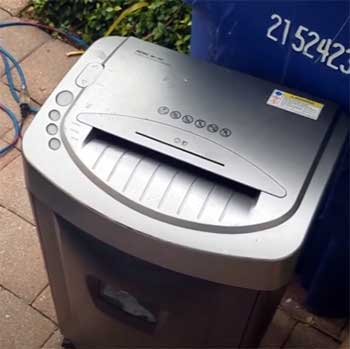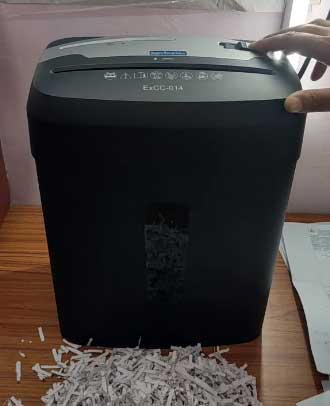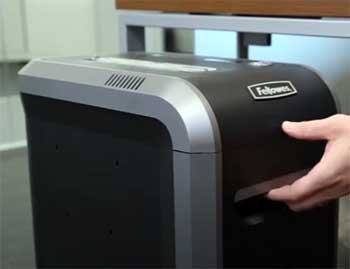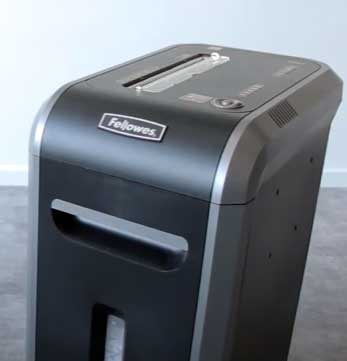I’ve spent years sorting through piles of sensitive documents, from bank statements to old tax forms, and one thing’s clear: a reliable paper shredder is a must for keeping your personal info safe.
In this article, I’m comparing two heavyweights in the shredder world—Royal and Fellowes—based on my hands-on experience and research. I’ll break down their features, weigh the pros and cons, and help you decide which brand suits your needs.
Whether you’re shredding a few bills or tackling a home office overhaul, I’ve got you covered with a detailed, user-focused analysis.
A Brief Comparison Table
| Feature | Royal | Fellowes |
| Shred Type | Micro-cut, Cross-cut | Micro-cut, Cross-cut |
| Sheet Capacity | 8–18 sheets | 8–18 sheets |
| Bin Size | 3.25–8.5 gallons | 5–9 gallons |
| Run Time | 5–40 minutes | 5–30 minutes |
| Cooldown Time | 30–45 minutes | 15–40 minutes |
| Noise Level | 60–80 dB | 59.7–70 dB |
| Safety Features | Basic safety switch | SafeSense, auto-reverse |
| Additional Features | Auto-feed on some models | Jam-proof, SilentShred |
| Price Range | $50–$200 | $60–$300 |
| Best For | Budget-conscious, light to medium use | High-volume, safety-focused users |
This table gives you a quick snapshot, but let’s dig into the details to see what these brands really bring to the table.
My Journey With Paper Shredders
As someone who’s worked from home for years, I’ve shredded everything from credit card offers to old client contracts. My first shredder was a cheap model that jammed constantly and sounded like a lawnmower. Frustrated, I upgraded to a Royal, then later tried a Fellowes.
Both brands have their strengths, but they cater to slightly different needs. I’ll walk you through my experience with their key features—shred type, sheet capacity, bin size, run time, noise, safety, and extra bells and whistles—to help you pick the right one.
Shred Type: Security First
When it comes to shredders, the cut type is a big deal—it’s about how secure your shredded documents are. Both Royal and Fellowes offer cross-cut and micro-cut options, which are leaps and bounds better than the outdated strip-cut models that leave long, reconstructible strips.
Royal’s Shred Types

Royal’s shredders, like the 14MC 14-Sheet Micro-Cut, slice paper into tiny confetti-like pieces (12mm x 4mm).
I shredded a stack of old bank statements with the Royal MC14MX, and the result was a pile of scraps so small I’d challenge any identity thief to piece them back together.
Their cross-cut models, like the 112MX, produce slightly larger shreds (32mm x 4mm), still secure enough for most home users.
The micro-cut is rated P-4 or P-5, meaning it’s ideal for sensitive documents, while cross-cut (P-3) works for less critical stuff like junk mail.
Pros:
- Micro-cut offers high security for personal and financial documents.
- Cross-cut models are faster and sufficient for general use.
Cons:
- Micro-cut shreds create more dust, which can be messy when emptying.
- Cross-cut models offer less security compared to micro-cut.
Fellowes’ Shred Types
Fellowes also delivers both micro-cut and cross-cut options. The Powershred 99Ci, a cross-cut model (P-4), produces strips about 4mm x 38mm—small enough to deter casual snooping.
I tested the Fellowes 62MC Micro-Cut, and its tiny shreds (around 4mm x 12mm) gave me peace of mind for shredding old tax forms. Fellowes’ micro-cut models are often P-4 or P-5, matching Royal’s security level, but their cross-cut shredders tend to have slightly larger shreds than Royal’s.
Pros:
- Micro-cut provides excellent security for confidential documents.
- Cross-cut models balance speed and security for everyday use.
Cons:
- Micro-cut bins fill up faster due to smaller shred sizes.
- Cross-cut shreds are less secure than micro-cut for sensitive documents.
Sheet Capacity: How Much Can They Handle?
Sheet capacity determines how many pages you can shred at once, which is crucial if you’re clearing out years of paperwork like I did during my last spring cleaning.
Royal’s Sheet Capacity

Royal’s range is impressive here. The Royal 1840MX Cross-Cut handles up to 18 sheets, while the 14MC Micro-Cut manages 14 sheets.
I stuffed 12 sheets into the 112MX, and it powered through without a hiccup.
For smaller jobs, models like the Royal CX88 handle 8 sheets, perfect for occasional use.
The higher-capacity models are great for small businesses or heavy home use, but even their lower-end models keep up with basic needs.
Pros:
- High-capacity models (14–18 sheets) tackle big stacks efficiently.
- Lower-capacity models are affordable for light users.
Cons:
- High-capacity shredders are bulkier and pricier.
- Some models struggle with thicker stacks near their max capacity.
Fellowes’ Sheet Capacity
Fellowes matches Royal closely. The Powershred 99Ci handles 18 sheets, and I found it breezed through a mix of paper and staples. The 79Ci takes 16 sheets, while the 62MC Micro-Cut is rated for 10 sheets. I tested the 79Ci with 15 sheets, and it didn’t jam, thanks to its anti-jam tech.
For lighter use, the Fellowes LX41-DB takes 8 sheets but feels clunkier due to its lift-up top. Fellowes’ range suits both heavy and light users, though their high-capacity models shine for bulk shredding.
Pros:
- High-capacity models (16–18 sheets) handle large jobs with ease.
- Anti-jam tech ensures smooth operation even at max capacity.
Cons:
- Lower-capacity models can be less user-friendly.
- Some models overpromise on sheet capacity, leading to jams if overloaded.
Bin Size: Less Emptying, More Shredding
The bin size affects how often you need to empty the shredder—a chore I dread when shreds get static-y and cling everywhere.
Royal’s Bin Size
Royal’s bins range from 3.25 gallons (112MX) to 8.5 gallons (MC14MX). The 14MC’s 4.5-gallon bin filled up after shredding about 100 sheets, which was enough for a small batch of documents.
The larger 8.5-gallon bin on the MC14MX was a game-changer when I tackled a box of old receipts—it held more before needing a trip to the recycling bin. However, smaller bins mean more frequent emptying, especially with micro-cut models.
Pros:
- Larger bins (8.5 gallons) reduce emptying frequency.
- Pull-out bins are easy to use and less messy than lift-off tops.
Cons:
- Smaller bins (3.25–4.5 gallons) fill up quickly with micro-cut shreds.
- Shreds can be static-y, making emptying a dusty hassle.
Fellowes’ Bin Size
Fellowes offers slightly larger bins, from 5 gallons (LX41-DB) to 9 gallons (99Ci). The 79Ci’s 6-gallon bin handled about 150 sheets before needing attention, which I appreciated during a long shredding session.
The 99Ci’s 9-gallon bin is a standout for high-volume users, though I found the pull-out basket a bit sticky at times. Fellowes’ bins are generally more spacious, which is a plus for frequent shredders.
Pros:
- Larger bins (6–9 gallons) suit heavy shredding tasks.
- Pull-out bins are convenient and user-friendly.
Cons:
- Sticky pull-out baskets can be annoying to empty.
- Smaller bins on budget models fill up fast.
Run Time and Cooldown: Endurance Matters
Run time is how long a shredder can operate before needing a break, and cooldown time is how long it takes to get back in action. This matters when you’re shredding a mountain of documents.
Royal’s Run Time and Cooldown
Royal’s run times vary widely. The 14MC offers 20 minutes, while the 1840MX boasts up to 40 minutes—impressive for a home shredder. I shredded for 15 minutes straight with the MC14MX, and it didn’t overheat, but the cooldown was a lengthy 40 minutes.
Smaller models like the CX88 manage only 5 minutes before needing a 45-minute break, which felt limiting when I had a big pile to get through.
Pros:
- High-end models (20–40 minutes) handle long sessions well.
- Reliable performance during rated run times.
Cons:
- Long cooldown times (30–45 minutes) slow down big jobs.
- Budget models have short run times (5 minutes).
Fellowes’ Run Time and Cooldown

Fellowes generally edges out Royal here.
The 99Ci runs for 30 minutes, and the 79Ci handles 20 minutes, both with cooldowns around 30 minutes.
I pushed the 62MC for 5 minutes, and it needed 40 minutes to cool down, which was frustrating.
The 99Ci’s 30-minute run time was a lifesaver during a marathon shredding session, and its shorter cooldown meant I could get back to work faster.
Pros:
- Longer run times (20–30 minutes) for high-volume shredding.
- Shorter cooldown times (15–30 minutes) on premium models.
Cons:
- Budget models have short run times (5 minutes).
- Cooldown can still disrupt workflow for heavy users.
Noise Level: Keeping It Quiet
Nobody wants a shredder that sounds like a jet engine, especially in a home office where Zoom calls are a regular thing.
Royal’s Noise Level
Royal shredders range from 60 dB (MC14MX) to 80 dB (CX88). The 60 dB on the MC14MX is like a normal conversation, which I found tolerable while working.
The 80 dB on the CX88, however, was loud enough to make me pause a podcast. Royal’s quieter models are great for shared spaces, but their budget options can be disruptive.
Pros:
- Some models (60 dB) are quiet enough for home offices.
- High-end models prioritize low noise.
Cons:
- Budget models (80 dB) are noticeably loud.
- No dedicated silent mode on most models.
Fellowes’ Noise Level
Fellowes shines here with their SilentShred technology. The 99Ci and 79Ci clock in around 59.7–62 dB, quieter than most Royal models. I used the 79Ci during a call, and it didn’t drown out my conversation. Even the 62MC, at 70 dB, was manageable.
Fellowes’ focus on quiet operation makes them ideal for home or small offices where noise is a concern.
Pros:
- SilentShred tech keeps noise low (59.7–62 dB).
- Quiet enough for shared or home office use.
Cons:
- Budget models can still hit 70 dB.
- Not all models have SilentShred.
Safety Features: Protecting Fingers and Pets
Safety is non-negotiable, especially if you have kids or pets around like I do with my curious cat.
Royal’s Safety Features
Royal’s safety features are basic but functional. Most models, like the 14MC, have a safety interlock switch that stops the shredder when the bin is removed.
I appreciated this when I accidentally bumped the bin while emptying it. However, there’s no advanced tech like hand-detection sensors, so you need to be cautious around the feed slot.
Pros:
- Safety interlock switch prevents accidents during bin removal.
- Reliable for basic safety needs.
Cons:
- Lacks advanced safety features like hand-detection.
- Budget models feel less secure for homes with kids.
Fellowes’ Safety Features

Fellowes steps it up with SafeSense technology, which stops the shredder if a hand gets too close to the feed slot.
I tested this on the 79Ci, and it halted instantly when my hand brushed the opening—perfect for my cat-prone household.
Most models also have auto-reverse for jams, which adds another layer of safety.
Fellowes clearly prioritizes user protection.
Pros:
- SafeSense tech stops shredder near hands or objects.
- Auto-reverse reduces jam-related risks.
Cons:
- SafeSense not available on all models.
- Budget models have minimal safety features.
Additional Features: The Extras That Matter
Both brands offer extras that can make shredding easier or more convenient, like auto-feed or jam protection.
Royal’s Additional Features
Royal’s high-end models, like the AU120MA, feature auto-feed trays that handle up to 120 sheets, saving me time when shredding a big stack. The auto-reverse on the 14MC helped clear a jam when I accidentally fed too many sheets.
However, budget models like the CX88 lack these perks, and some users report issues with bags interfering with safety switches.
Pros:
- Auto-feed on premium models saves time.
- Auto-reverse helps with occasional jams.
Cons:
- Budget models lack advanced features.
- Bag compatibility can be an issue.
Fellowes’ Additional Features
Fellowes’ jam-proof tech, found on the 99Ci and 79Ci, is a standout. I fed 16 sheets into the 79Ci, and it powered through without stalling. SilentShred keeps things quiet, and some models have LED indicators for bin fullness or overheating.
The AutoMax 130C’s auto-feed handles 130 sheets, which was a lifesaver during a big cleanup. These features make Fellowes feel more polished.
Pros:
- Jam-proof tech ensures smooth operation.
- SilentShred and LED indicators enhance usability.
Cons:
- Premium features drive up cost.
- Wheels often require manual assembly.
Price and Value: Bang for Your Buck
Price is where Royal often pulls ahead, but Fellowes offers premium features that might justify the cost.
Royal’s Price and Value
Royal shredders range from $50 (CX88) to $200 (1840MX). The 14MC, around $100, offers solid value for home use with its 14-sheet capacity and micro-cut security. I found the MC14MX’s $150 price tag reasonable for its 8.5-gallon bin and 40-minute run time.
Royal’s budget models are great for light users, but their durability can be hit-or-miss.
Pros:
- Affordable options for light to medium use.
- Good balance of features and price.
Cons:
- Durability concerns with budget models.
- Fewer premium features than Fellowes.
Fellowes’ Price and Value
Fellowes shredders range from $60 (LX41-DB) to $300 (99Ci). The 79Ci, around $200, feels like a worthwhile investment for its safety and jam-proof features.
I paid $250 for the 99Ci, and its 30-minute run time and 9-gallon bin made it worth every penny for heavy shredding. However, budget models like the LX41-DB feel overpriced for their basic features.
Pros:
- Premium models offer excellent durability and features.
- High-end models justify cost for heavy users.
Cons:
- Higher price point than Royal.
- Budget models lack value compared to Royal.
Which Should You Choose?
After testing both brands, I lean toward Fellowes for its superior safety features, quieter operation, and jam-proof tech, especially if you shred frequently or have a busy home office. The Powershred 99Ci or 79Ci are my go-tos for their balance of capacity, durability, and user-friendly features.
However, Royal’s 14MC or MC14MX are fantastic if you’re on a budget or need a shredder for occasional use. Their affordability and solid performance make them hard to beat for light to medium tasks.
Your choice depends on your needs. If safety and quiet operation are priorities, spend a bit more on Fellowes. If you want value and don’t need all the bells and whistles, Royal’s got you covered. Either way, both brands will keep your sensitive documents out of the wrong hands.
Frequently Asked Questions (FAQ)
It depends on your needs. Fellowes excels for heavy use and safety, while Royal offers great value for light to medium tasks.
Fellowes is often preferred for its durability, safety features, and quiet operation, but Royal is a strong contender for budget-conscious users.
The Fellowes Powershred 99Ci is top-tier for home offices due to its 18-sheet capacity, 30-minute run time, and SafeSense tech. For budget users, the Royal 14MC is a solid pick.
Fellowes ranks higher for premium features and reliability, followed by Royal for affordability. Other brands like Aurora and Amazon Basics are also worth considering for specific needs.
Conclusion: Your Shredder, Your Choice
You’ve got a pile of sensitive documents waiting to be destroyed, and both Royal and Fellowes can help you get the job done. I’ve shared my experience with their shredders, from Royal’s budget-friendly power to Fellowes’ high-tech reliability.
If you prioritize safety and long run times, Fellowes is your best bet. If you’re looking for value without sacrificing security, Royal’s got your back. Think about your shredding habits—how much, how often, and how secure you need it to be—and pick the shredder that fits your life.
You’ll sleep better knowing your info is safe.
